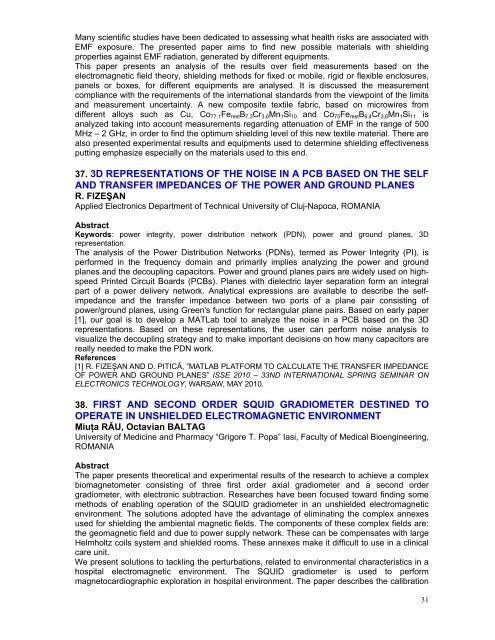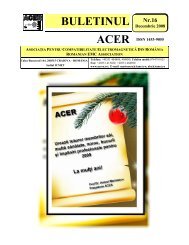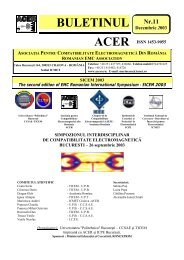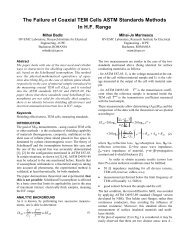the 8th international workshop of electromagnetic compatibility
the 8th international workshop of electromagnetic compatibility
the 8th international workshop of electromagnetic compatibility
You also want an ePaper? Increase the reach of your titles
YUMPU automatically turns print PDFs into web optimized ePapers that Google loves.
Many scientific studies have been dedicated to assessing what health risks are associated with<br />
EMF exposure. The presented paper aims to find new possible materials with shielding<br />
properties against EMF radiation, generated by different equipments.<br />
This paper presents an analysis <strong>of</strong> <strong>the</strong> results over field measurements based on <strong>the</strong><br />
<strong>electromagnetic</strong> field <strong>the</strong>ory, shielding methods for fixed or mobile, rigid or flexible enclosures,<br />
panels or boxes, for different equipments are analysed. It is discussed <strong>the</strong> measurement<br />
compliance with <strong>the</strong> requirements <strong>of</strong> <strong>the</strong> <strong>international</strong> standards from <strong>the</strong> viewpoint <strong>of</strong> <strong>the</strong> limits<br />
and measurement uncertainty. A new composite textile fabric, based on microwires from<br />
different alloys such as Cu, Co 77,1 Fe rest B 7,3 Cr 3,6 Mn 1 Si 10 and Co 75 Fe rest B 9,4 Cr 3,6 Mn 1 Si 11 is<br />
analyzed taking into account measurements regarding attenuation <strong>of</strong> EMF in <strong>the</strong> range <strong>of</strong> 500<br />
MHz – 2 GHz, in order to find <strong>the</strong> optimum shielding level <strong>of</strong> this new textile material. There are<br />
also presented experimental results and equipments used to determine shielding effectiveness<br />
putting emphasize especially on <strong>the</strong> materials used to this end.<br />
37. 3D REPRESENTATIONS OF THE NOISE IN A PCB BASED ON THE SELF<br />
AND TRANSFER IMPEDANCES OF THE POWER AND GROUND PLANES<br />
R. FIZEŞAN<br />
Applied Electronics Department <strong>of</strong> Technical University <strong>of</strong> Cluj-Napoca, ROMANIA<br />
Abstract<br />
Keywords: power integrity, power distribution network (PDN), power and ground planes, 3D<br />
representation.<br />
The analysis <strong>of</strong> <strong>the</strong> Power Distribution Networks (PDNs), termed as Power Integrity (PI), is<br />
performed in <strong>the</strong> frequency domain and primarily implies analyzing <strong>the</strong> power and ground<br />
planes and <strong>the</strong> decoupling capacitors. Power and ground planes pairs are widely used on highspeed<br />
Printed Circuit Boards (PCBs). Planes with dielectric layer separation form an integral<br />
part <strong>of</strong> a power delivery network. Analytical expressions are available to describe <strong>the</strong> selfimpedance<br />
and <strong>the</strong> transfer impedance between two ports <strong>of</strong> a plane pair consisting <strong>of</strong><br />
power/ground planes, using Green's function for rectangular plane pairs. Based on early paper<br />
[1], our goal is to develop a MATLab tool to analyze <strong>the</strong> noise in a PCB based on <strong>the</strong> 3D<br />
representations. Based on <strong>the</strong>se representations, <strong>the</strong> user can perform noise analysis to<br />
visualize <strong>the</strong> decoupling strategy and to make important decisions on how many capacitors are<br />
really needed to make <strong>the</strong> PDN work.<br />
References<br />
[1] R. FIZEŞAN AND D. PITICĂ, ”MATLAB PLATFORM TO CALCULATE THE TRANSFER IMPEDANCE<br />
OF POWER AND GROUND PLANES” ISSE 2010 – 33ND INTERNATIONAL SPRING SEMINAR ON<br />
ELECTRONICS TECHNOLOGY, WARSAW, MAY 2010.<br />
38. FIRST AND SECOND ORDER SQUID GRADIOMETER DESTINED TO<br />
OPERATE IN UNSHIELDED ELECTROMAGNETIC ENVIRONMENT<br />
Miuţa RĂU, Octavian BALTAG<br />
University <strong>of</strong> Medicine and Pharmacy “Grigore T. Popa” Iasi, Faculty <strong>of</strong> Medical Bioengineering,<br />
ROMANIA<br />
Abstract<br />
The paper presents <strong>the</strong>oretical and experimental results <strong>of</strong> <strong>the</strong> research to achieve a complex<br />
biomagnetometer consisting <strong>of</strong> three first order axial gradiometer and a second order<br />
gradiometer, with electronic subtraction. Researches have been focused toward finding some<br />
methods <strong>of</strong> enabling operation <strong>of</strong> <strong>the</strong> SQUID gradiometer in an unshielded <strong>electromagnetic</strong><br />
environment. The solutions adopted have <strong>the</strong> advantage <strong>of</strong> eliminating <strong>the</strong> complex annexes<br />
used for shielding <strong>the</strong> ambiental magnetic fields. The components <strong>of</strong> <strong>the</strong>se complex fields are:<br />
<strong>the</strong> geomagnetic field and due to power supply network. These can be compensates with large<br />
Helmholtz coils system and shielded rooms. These annexes make it difficult to use in a clinical<br />
care unit.<br />
We present solutions to tackling <strong>the</strong> perturbations, related to environmental characteristics in a<br />
hospital <strong>electromagnetic</strong> environment. The SQUID gradiometer is used to perform<br />
magnetocardiographic exploration in hospital environment. The paper describes <strong>the</strong> calibration<br />
31







